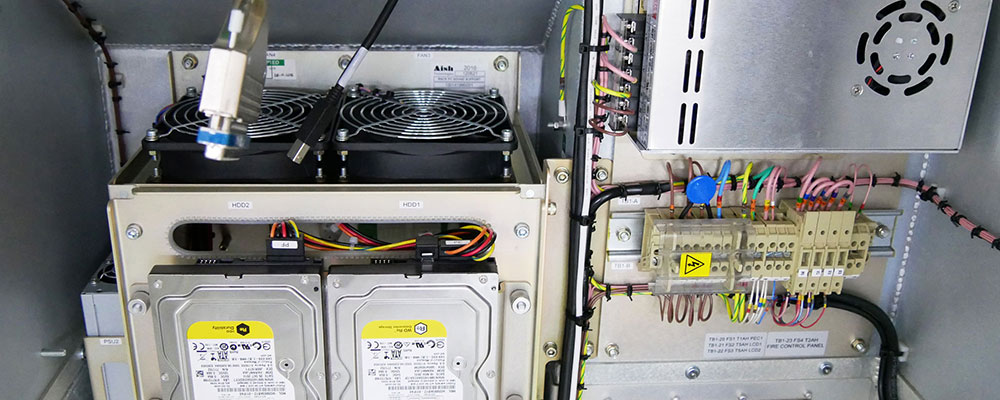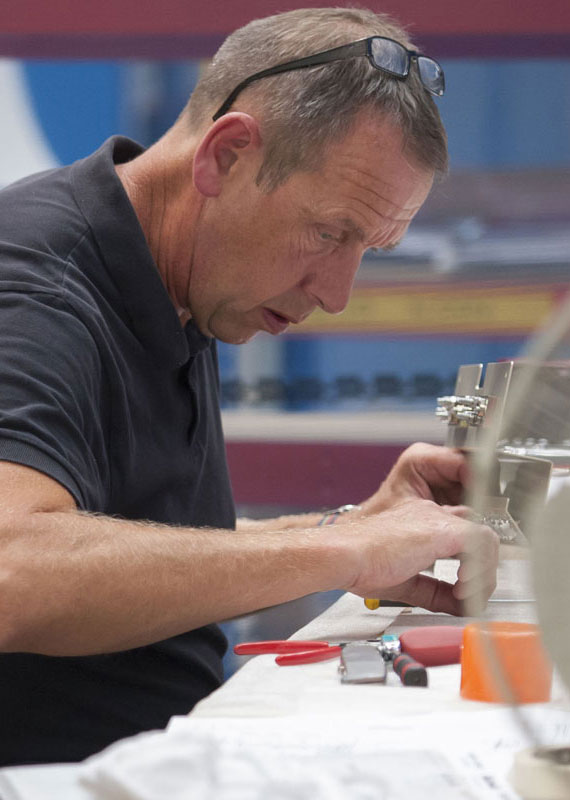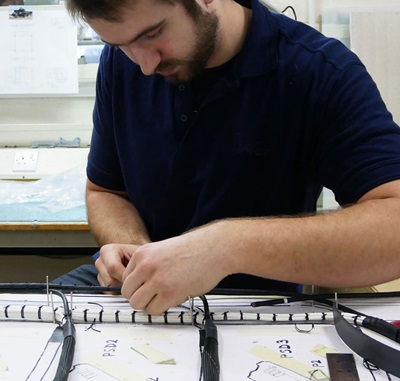
Bringing together Engineering, Supply Chain, and Manufacturing through the Digital Thread
Aish Technologies is a British systems design and manufacturing company with a rich history of innovation. Located in Poole, UK, Aish Technologies started in the mid-20th century by supplying electrical systems to naval vessels. Today it is a key supplier of custom-manufactured electrical units, cabinetry and multi-function consoles for subsurface and surface platforms designed for the British Royal Navy and the U.S. Navy. The manufacturer specializes in naval and military electronics hardware, as well as low signature Impressed Cathodic Protection systems (ICCP) to provide corrosion protection for vessels and rigged enclosures and cabinets.
With 180 employees, 40 of which are in the engineering department, the company focuses on continuous improvement while remaining innovative, agile, and a responsive supplier to the defense market.
However, with demanding customers in the defense sector that have strict requirements, Aish Technologies was looking to improve quality and better align product development processes. With this goal in mind, the manufacturer embarked on its digital transformation journey to implement a digital thread and increase new product introduction (NPI).
Targeting a challenging customer base
The defense industry has inconsistent demand and presents significant timing risks on order placements. This situation can be feast or famine for contractors depending on government budgets and world affairs. It is crucial for them to be able to capture demand and produce high-quality, custom products to support the defense customer’s objectives.
In addition, defense projects are often subject to the strictest requirements and standards which any contractors’ products must comply with. All while dealing with very tight deadlines, which doesn’t allow for much prototyping. On top of that, naval ships are on a periodic refit cycle and the contractor must be agile enough so that its products meet the latest requirements. Agility is something Aish Technologies was struggling with.
Addressing these challenges was a significant undertaking for Aish Technologies. Its engineering department was producing a lot of product data but lacked an effective way of managing it. Paper-based and manual processes created additional challenges. There were information silos and miscommunication between the engineering and manufacturing departments. This situation resulted in slower production cycles, which left the door open for human error, and relied on the knowledge of individual members of the production team. Aish Technologies realized it needed to implement a digital thread quickly.

 Identifying opportunities and
executing a strategy
Identifying opportunities and
executing a strategy
In 2019 senior leadership saw the value and importance of digitally transforming to enable long term success. Aish Technologies’ ultimate goal was to create digital twins of its products. To get there, it set goals that would impact each part of the production process, as well as establish fundamental building blocks for the digital twin:
- Engineering and design: It improved product data management by taking a part centric approach to establishing an engineering bill of materials (EBOM). This included adding 3D cabling data to master 3D≈models.
- Manufacturing and production: The manufacturer wanted to deliver clear, 3D work instructions to the shop floor to minimize errors. 3D is key for any work that involves intricate and extensive cabling because it is extremely difficult and time consuming for those in production to understand how cables need to be routed based solely on 2D paper-based work instructions and wiring schedules. In order to do so, Aish Technologies needed to:
- Establish a manufacturing bill of materials (MBOM) and connect it to the 3D work instructions to allow the technician to view the complete 3D representation of what they’re going to build.
- Build the necessary infrastructure required to present this information to the technicians in manufacturing.
- Change management: The manufacturer aimed to implement changes faster and cut down on change cycles. This is particularly important when Aish Technologies needs to react to customer changes during a tight design and manufacture schedule and for future update and upgrade cycles for the products they are building.
- Quality control: Once real-time data was available throughout production, management wanted to leverage it to speed up the quality inspection process.
With these upgrades in place, Aish Technologies was paving the way for future improvements with a single source of product truth and a digital thread.
Delivering a single source of truth for digital transformation
To accomplish its goals, Aish Technologies needed a PLM solution that could increase efficiency and accuracy in its design and manufacturing processes. Also, being able to close information gaps and ensure data integrity and quality across the entire value chain was critical to its digital transformation success. To get there, key stakeholders needed to be on board. Senior management helped everyone in engineering, supply chain, and manufacturing understand the value of adopting a digital thread. Changes were implemented quickly. The manufacturer’s workforce was able to see the investment and value of making these changes to ways of working and fully supported the transformation.
Windchill integrates seamlessly
with our other PTC and third-party
products. We never discuss Windchill
as separate from other PTC products
because we see them as a unifi ed
set of tools powering our digital
transformation.
Aleesha Mitchell, UK Engineering Director - Aish Technologies.
The NAVY supplier set out to establish a digital thread and consistent product architecture with Windchill. This comprehensive PLM software enables data governance and traceability, providing out-of-thebox functionality to realize value quickly through standardized processes. It delivers the core product data management (PDM), configuration and change management, BOM management, and project management capabilities that facilitates securely sharing consistent product data across disciplines, geographies, divisions, and external partners.
Windchill’s open architecture enables seamless integration to manage, associate, orchestrate, and flexibly deliver data across the value chain. Instead of working in siloed systems and manually handing over product data, Windchill enables all teams to collaboratively manage product hardware complexity in one place across all their products.
Leveraging their small size, Aish Technologies ramped up its digital transformation
To implement Windchill, Aish Technologies partnered with Root Solutions who created a roadmap that delivered value every step of the way.
Aish Technologies needed to better manage its CAD data and create process documentation. Similarly, the company needed to create engineering bills of materials (EBOMS) and manufacturing bills of materials (MBOMS). After that, Aish Technologies would use the foundation they had built to improve supplier parts management and serve work instructions to the shop floor.
Windchill provides Aish Technologies with a single source of truth across the design and manufacturing processes. It drives agility, standardization, and scalability. As a small, agile company that leveraged digital transformation, the manufacturer was able to act quickly to implement use cases. These use cases include:
- Design engineering – Aish Technologies implemented a common system for managing its product data. This update allowed it to move away from manual processes and data management to a system that allows the seamless delivery of information and real-time visibility of upstream and downstream product data. With the standardized system in place, Aish Technologies increased efficiency due to decreased manual handovers.
- Production preparation – Prior to Windchill,
Aish Technologies’ engineers would design a
model and manually input the information into the
Material Requirements Planning (MRP) system.
Then, manufacturing would build the product
based on 2D models, which were hard to interpret, especially for routing cabling. The manufacturer
had no way to transfer product data from
engineering to manufacturing or track changes
that occurred later.
Windchill helped connect every part of the production process with a consistent thread of data, enabling a smooth transition of information from engineering to manufacturing. With help from Root Solutions, Aish Technologies started by creating MBOMs and EBOMs. Then, it established a connection between the two, which reduced human error and accelerated speed from design to production. - Piping and cabling – Cables, pipes, and wires
are extremely difficult to route and always
pose a challenge. Without an efficient way to
manage or automate the routing while designing,
piping and cabling end up being an inefficient
design process.
Aish Technologies began by implementing a product called Creo Piping and Cabling Extension on smaller projects. After an initial success, engineers started implementing it on larger projects, learning as they went and pushing innovation across the business. With piping and cabling installed, the company has saved time in the design process and the product assembly phase. - Engineering change management – Windchill enables Aish Technologies to create and track all change management requests in one system. With EBOMs and MBOMs connected through Windchill, engineers can work from a single source of information and gain real-time visibility into change requests coming from the shop floor or from customers. This increased efficiency and data reliability helps minimize human error and allows for important change requests to be accessible to the right people when they need it.
- Delivering the right instructions to the shop floor at the right time with ThingWorx Navigate - Before Aish Technologies’ digital transformation, 2D drawings were used as work instructions, which were hard to interpret. It was difficult to route cables based on these drawings. An efficiency improvement was needed. The company leveraged ThingWorx Navigate to create step-by-step work instructions on the shopfloor. In the ThingWorx kiosk, workers can see and interact with the 3D models in a step-bystep manner. This information is created in Creo, stored in Windchill, and delivered to the shopfloor via ThingWorx Navigate. Root Solutions created dashboards in ThingWorx that collect and display data and presents users with relevant, actionable information. Aish Technologies was able to leverage data throughout the enterprise, resulting in greater accuracy and less human errors on the shop floor.
- Reducing inspection time with a “closed-loop” for quality – With an additional investment in a scanning arm on the shop floor, Aish Technologies sees the full benefits of integrating 3D models and IoT into its production cycle. The combined functionality of the scanning arm and models enables the manufacturer to reduce its inspection time, saving valuable time in the production cycle and accelerating the manufacturing process.
The shop floor is now able to gain
the information presented to them
without room for interpretation.
Now they can see the 3D model, go
through it step by step, expand it, or
click into it at a certain area. The shop
floor has really embraced this new
technology. ThingWorx Navigate has
been integral to this change.
Aleesha, Engineering Director - Aish Technologies
Root Solutions:
Root Solutions is a UK Platinum PTC Partner providing PTC software solutions, training, expert support, and tailored services across the PTC product range. Established in 1992, Root Solutions has a depth of experience improving engineering and design processes. Due to their agility and expertise, Root Solutions’ partnership with Aish Technologies resulted in the navy supplier realizing more value from their digital transformation than would be possible alone.
“Root Solutions guided us in the right direction, and they were able to pull us back on track when needed. The leadership from Root Solutions was crucial,” said Aleesha Mitchell, Head of Engineering at Aish Technologies.
The digital thread set the stage for a
successful future at Aish Technologies
Aish Technology’s next focus will be on using AR to display work instructions on the shop floor. Also, to further leverage Windchill’s many capabilities to extend its digital transformation across the enterprise:
- Using Windchill to manage quality services, such as non-conformity reporting
- Shifting from using technical data packages in its communication with prime contractors to using Windchill to securely transfer data to prime contractors
- Managing requirements using Windchill
- Creating a digital twin to closely track the projection of its products across operational processes.